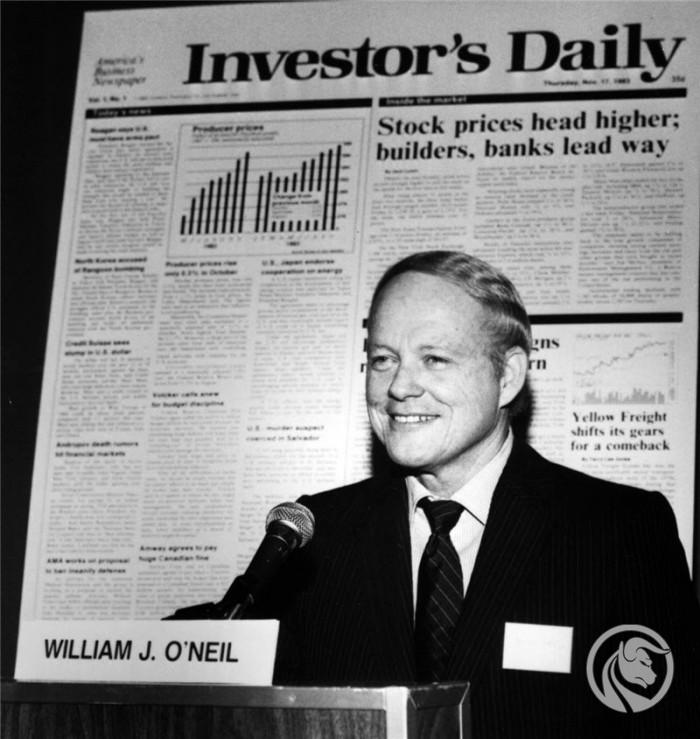William O'Neil - creator of CAN SLIM [BIG TRADERS]
William O'Neil is one of the best investors ever. He is the creator of a unique stock selection strategy called CAN SLIM. He was also known for investing in "Growth companies" before it was fashionable.
W. O'Neil was born on March 25, 1933 in Oklahoma City. So his childhood fell on the time of the Great Depression, which plunged the largest economy in the world, which was the United States. The Great Depression did not shake his faith in "American dream". In 1951 he graduated Woodrow Wilson High School in Dallas, then attended Southern Methodist University.
William O'Neil: The Beginnings of a Career
William O'Neil began his career in the financial market in the 1958s. In XNUMX, he began working as a stockbroker for Hayden Stone & Company. Trying to gain an advantage over the market, he began research on creating a strategy that would allow him to permanently "beat the market". He started his research by analyzing the financial results of the best funds operating on the American market. His attention was caught by the Dreyfus Fund, which managed to consistently beat the market benchmark. William O'Neil began reading the fund's quarterly reports and also began charting when new stocks were purchased. As a result, he discovered that the fund's focus was not on buying companies in a downtrend, but on rising stock prices. A careful analysis of the Dreyfus Fund system helped William discover the importance of the current stock market trend. Time spent at Hayden Stone & Company laid the foundations for the future: CAN SLIM.
Way to the top
 The analysis of the competition's results and own conclusions made it possible to shape the investment strategy. The research has been used in practice. In the years 1962-1963, the investor multiplied his capital 40 times. This result was helped by a short game on Korvette shares, the purchase of shares in Chrysler and Syntex (producer of contraceptive pills, among others). Thanks to the accumulated capital, William was able to buy a seat on the New York Stock Exchange (NYSE).
The analysis of the competition's results and own conclusions made it possible to shape the investment strategy. The research has been used in practice. In the years 1962-1963, the investor multiplied his capital 40 times. This result was helped by a short game on Korvette shares, the purchase of shares in Chrysler and Syntex (producer of contraceptive pills, among others). Thanks to the accumulated capital, William was able to buy a seat on the New York Stock Exchange (NYSE).
Moreover, the trader founded an analytical and brokerage firm called William O'Neil & Co. Thanks to focusing on quality, his venture turned out to be a success. Thanks to diligence and the right selection of employees, the company quickly became one of the most significant analytical companies on the American market. The next business of the trader was the newspaper "Investor's Daily"that threw gloves to the market leader, i.e. the newspaper Wall Street Journal.
Despite running two companies, William O'Neil continued to achieve strong returns. In the 70s and 80s, the average annual rate of return exceeded 40%. The proper selection of companies helped to achieve such high rates of return. An investor bought me a Canadian oil companies in the 70s, helped by the increase in raw material prices. He was also a shareholder of companies such as Pic'n'Save and Price Co.
Although the investor paid attention to the market situation, he could think independently. Thanks to this, he was able to "sense" changes in the stock market trend. The most glaring example was the purchase of two-page advertisements in the Wall Street Journal that encouraged stock buyers. Such advertisements were bought in March 1978 and February 1982. This coincided with the start of the bull market in US equities.
CAN SLIM system
In his research on selecting the best companies, William O'Neil conducted a series of statistical studies that allowed him to formulate a rule called CAN SLIM. This system was tested on computers, which was a rare solution at that time. The CAN SLIM rule is an acronym:
- Bunk C (current) relates to companies whose revenues in the quarter grow at an annual rate of 20% to 50%. According to statistical surveys, such companies have the greatest growth potential.
- Bunk A (annual) this letter refers to earnings per share (EPS). For the author of the rule, the key factor was the average annual increase in earnings per share. It is essential that the dynamics of EPS be faster than companies operating in the same industry. In this case, the company is doing better than the competition, which is a good "fundamental" forecast.
- Bunk N (new) refers to new, often breakthrough products. These can be both new business lines and a new version of an existing product. However, the letter N is also an indication that the new highs can also be a hint for traders.
- Bunk S (shares) tells you to try to find shares with as few shares as possible. This suggests that the investor should not only focus on large companies with huge capitalization, but also look for opportunities in the SME sector.
- Bunk L The (leader) author of CAN SLIM suggests focusing your attention on the values that are industry leaders. The key factor in this case is the relative strength index, which determines how the company's assets compared to the competition.
- Bunk I (institution), i.e. participation in the shareholding structure of financial institutions. Industry leaders are eagerly bought by institutions. However, too high share of institutions in the shareholder structure suggests that their demand will be rather small. An ideal company is an industry leader with a small number of institutions in the shareholding structure. The lack of institutions offers the potential for "institutional demand" which may contribute to an increase in the company's stock.
- Bunk M (market) means that even the best bearish company will depreciate. Therefore, constant monitoring of the market situation is crucial for achieving long-term growth. The letter M is also important for capital management. William O'Neil always places a stop loss order and when the company loses 7% it is automatically removed from the portfolio. This allows you to cut losses and protect the investor's capital.
It is worth noting that in the CAN SLIM strategy there is no mention of diversification or dividends. For the creator of the system, the dividend is of marginal importance. This is because the most profit is made from changing the share price. The dividend is just an add-on. Additionally, if a business is growing rapidly, it makes more sense to reinvest cash in the business than to pay dividends to investors. According to William O'Neil, portfolio diversification justifies ignorance. The more companies, the lower the risk of error. However, the cost is "dilution of profits." According to the creator of CAN SLIM, it is crucial for an investor to have a maximum of 6-7 companies in the portfolio, because it does not unnecessarily fragment the capital.
According to William, one should also beware of the most common mistakes made by investors. These include:
- Buying on downturns when there are no signals of a trend reversal. This "freezes capital" and is mentally destructive for many investors.
- Buying cheap, third-rate companies that are not industry leaders. Such a buying of companies is not a good solution for the reason that a tertiary company is not a leader for objective reasons. It could be a worse product or service, or a weaker management.
- Price averaging downwards.
- Buying nominally cheap stocks because they are "cheap".
- Willingness to get rich quick, which wastes time and capital. The desire for quick profits can push you to invest in popular companies and buy uphill. In addition to the uptrend, it is also worth using other "filters".
- Buying on impulse, rumor, indicator.
- Buying third-rate companies with tempting P / E or high dividends. This is a misinterpretation of "value investing." Often times, a company has a tempting ratio for specific reasons (eg, falling profits and revenues because the industry is "dying").
- Acquiring stocks of companies just because everyone knows them. A well-known company does not mean a good investment. Those who invested in Lehman Brothers and General Electric stocks in 2007 have found out about it.
- Fear of buying stocks that are reaching new price highs. This is one of the fundamental mistakes. New highs are not always a sign of "overheating", but of improving financial results.
- Cutting profits and keeping losses.
- To speculate on cheap options because that's the way to get rich quick. As a result, the investor is exposed to the "time decay" phenomenon.
- Lack of objectivity when analyzing the company and the market environment. This leads to an overly optimistic or too pessimistic view of the company's products and services. In particular, too strong optimism concerns investors who have already purchased shares of a certain company. As a result, some of them "filter" the messages to "fit the narrative". Investors should always be impartial and analyze companies objectively (both in technical and fundamental analysis).
O'Neil is certainly one of the greatest traders in history. His explicit stock selection rules inspired many other investors. His investment strategy is a kind of combination of technical and fundamental analysis. It is also worth mentioning that William O'Neil wrote a very famous book: How to make money in stocks.






















![Forex Club – Tax 9 – Settle tax on a foreign broker [Download the Application] Forex Club - Tax 9](https://forexclub.pl/wp-content/uploads/2024/02/Forex-Club-Podatek-9-184x120.jpg?v=1709046278)
![Trading View platform – solutions tailored to the needs of traders [Review] trading view review](https://forexclub.pl/wp-content/uploads/2024/03/trading-view-recenzja-184x120.jpg?v=1709558918)
![How to connect your FP Markets account to the Trading View platform [Guide] fp markets trading view](https://forexclub.pl/wp-content/uploads/2024/02/fp-markets-trading-view-184x120.jpg?v=1708677291)
![How to invest in ChatGPT and AI? Stocks and ETFs [Guide] how to invest in chatgpt and artificial intelligence](https://forexclub.pl/wp-content/uploads/2023/02/jak-inwestowac-w-chatgpt-i-sztuczna-inteligencje-184x120.jpg?v=1676364263)


![WeWork – the anatomy of the collapse of a company valued at $47 billion [WeWork, part II] wework bankruptcy story](https://forexclub.pl/wp-content/uploads/2024/04/wework-bankructwo-historia-184x120.jpg?v=1711729561)
![Adam Neumann – the man who screwed up Softbank [WeWork, part AND] adam neumann wework](https://forexclub.pl/wp-content/uploads/2024/04/adam-neumann-wework-184x120.jpg?v=1711728724)





![How to transfer shares to another brokerage office [Procedure description] how to transfer shares to another brokerage house](https://forexclub.pl/wp-content/uploads/2024/03/jak-przeniesc-akcje-do-innego-biura-maklerskiego-184x120.jpg?v=1709556924)

![The most common mistakes of a beginner trader - Mr Yogi [VIDEO] Scalping - The most common mistakes of a beginner trader - VIDEO](https://forexclub.pl/wp-content/uploads/2024/03/Scalping-Najczestsze-bledy-poczatkujacego-tradera-VIDEO-184x120.jpg?v=1711601376)
![Learning patience: No position is also a position - Mr Yogi [VIDEO] Scalping - Learning patience - No position is also a position - VIDEO](https://forexclub.pl/wp-content/uploads/2024/03/Scalping-Nauka-cierpliwosci-Brak-pozycji-to-tez-pozycja-VIDEO-184x120.jpg?v=1710999249)
![When to exit a position and how to minimize losses - Mr Yogi [VIDEO] Scalping - When to exit a position and how to minimize losses - VIDEO](https://forexclub.pl/wp-content/uploads/2024/03/Scalping-Kiedy-wyjsc-z-pozycji-i-jak-minimalizowac-straty-VIDEO-184x120.jpg?v=1710336731)


![William O'Neil - creator of CAN SLIM [BIG TRADERS]](https://forexclub.pl/wp-content/uploads/2021/04/william-oneil.jpg?v=1617785965)



![William O'Neil - creator of CAN SLIM [BIG TRADERS]](https://forexclub.pl/wp-content/uploads/2021/04/wydobywanie-kryptowalut-kac-102x65.jpg?v=1617782345)
![William O'Neil - creator of CAN SLIM [BIG TRADERS] PLN, zloty on the rise](https://forexclub.pl/wp-content/uploads/2019/12/polska_pln_wykres-102x65.jpg?v=1576651935)









